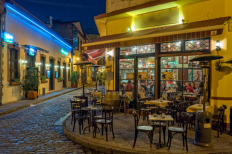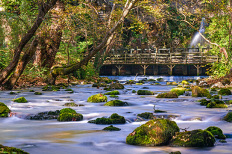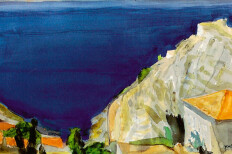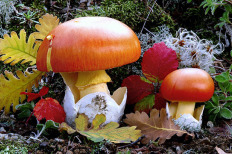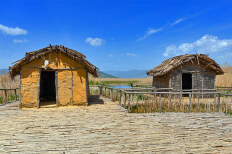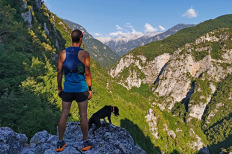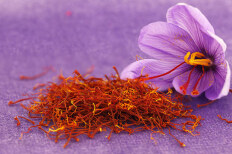
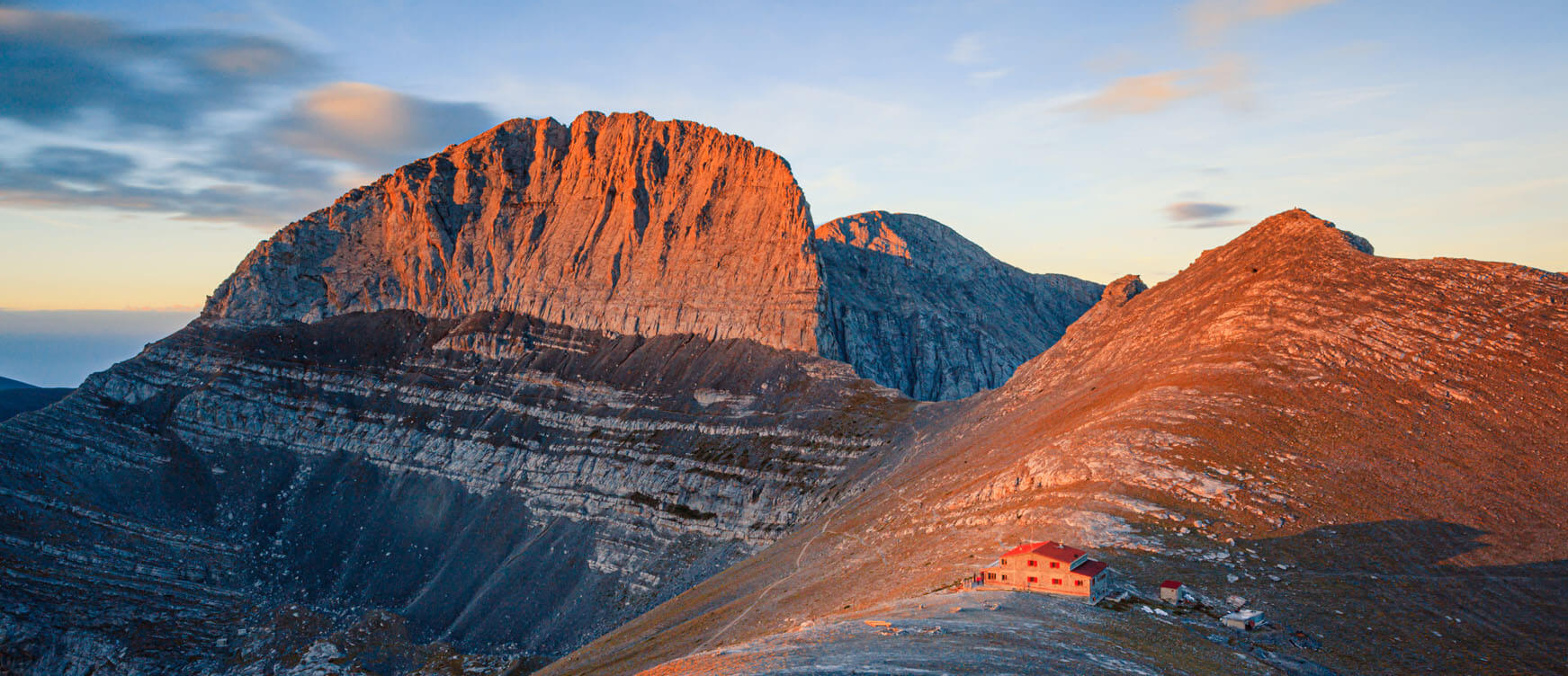
Macedonia
The Land Of Alexander The Great
Visit Macedonia where you will encounter unique images. Explore this magnificent place in Greece where east meets west. The imposing – and almost perennial snowy – massifs of unique beauty boast Mt Olympus, the country's most famous and highest mountain, which is followed by the equally beautiful Pangaio, Kaimaktsalan (Voras) and Falakro mountains, where you can enjoy hiking, skiing or snowboarding during winter.
The water element is significantly present with some of the most important rivers and lakes in Greece flowing through Macedonia. Visit the metropolis of the North, Thessaloniki, with an intriguing multi-ethnic history and arty counter culture. It is a lively modern place, bustling with energy and verve. Built amphitheatrically around the sea, facing Mount Olympus on the distant horizon, it has always been a centre of different civilizations, cultures, nations and religions. Discover breathtaking Halkidiki with its clear waters and golden sand beaches, bays, little islands and green landscapes that will make your dream vacation come true! Don’t miss the unique beauty of Serres nature; the picturesque cities of Drama, Kavala on the East; and Kastoria and Naousa on the West.




Popular Destinations

Thessaloniki
City of Experiences
The metropolis of Thessaloniki has a population of over a million and is the biggest city in the northern part of Greece. It is built by Thermaïkos and Strymonikos Gulf, on fertile grounds resting beside the Rivers of Axios, Gallikos and Loudias, as well as the lakes Koroneia and Volvi.
Findings prove that Thessaloniki has been inhabited since prehistoric times, marked by multiculturalism, yet its present day modernised state is charmingly intertwined with archaeological sites, byzantine churches and other significant monuments from the past.
Thessaloniki is a busy, bustling city at all times of the day but especially at night when it becomes brighter and colourful.

Halkidiki
A breathtaking combination of blue and green
Shaped like Poseidon’s trident, Halkidiki’s prongs jut out into the Aegean Sea. Lush green forests extend all the way to the beachfront where reflections of golden sunlight add sparkling hues to turquoise waters. Long stretches of beautiful ever-changing shoreline, unique archaeological sites, world-renowned Christian monuments, lesser-known natural wonders and man-made masterpieces have all helped shape the region’s diverse identity, made even more interesting by the rich local culinary and cultural heritage.

Drama
Built at the foot of the imposing Falakro Mt, in a verdant area with abundant water sources, Drama is beautiful and hospitable, featuring picturesque neighbourhoods, spacious squares, green areas and well preserved neoclassical mansions.
A very few archaeological finds show that in the area of the modern city there used to be a settlement named Dyrama or Hydrama. This was the place of worship for many Gods of the Greco-Roman Pantheon (Apollo, Artemis, Isis, Hercules, and Dionysus). During the Byzantine years, there was a city possibly named "Draviskos" in the same area. In the middle Byzantine Period (9th-13th centuries) Drama was a fortified city with a castle and it used to be a commercial and military junction. In the late 19th century, tobacco production and trade, the operation of the railway (1895) and improvement of the road network towards the Port of Kavala, led to an increase in the population of the city and to the enhancement of the commercial activity. In the early 20th century Drama was occupied by the Bulgarians and participated in the Macedonian Struggle, but was liberated by the Greek Army on July 1st 1913. It is located at a distance of 650km NE of Athens and 150km NE of Thessaloniki.
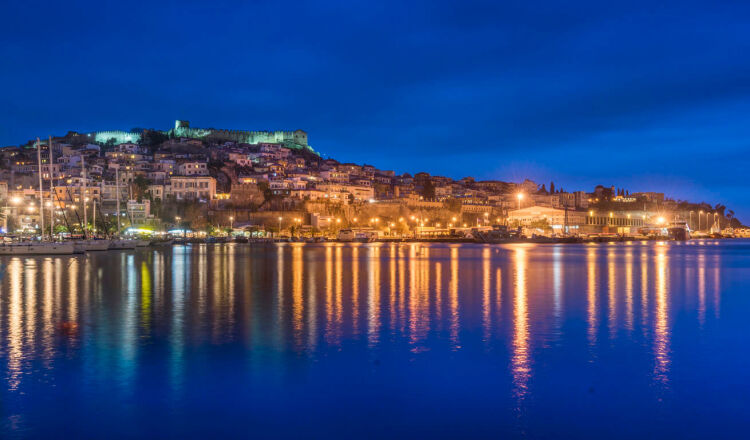
Kavala
The city of Kavala is built on a hillside along the coast of the Aegean sea, a cultural crossroad between the East and West, which has everything you could wish for in a destination and more; mountains, beaches, picture perfect cityscapes, breathtaking views, significant monuments and sites, delicious local cuisine and amazing places to discover at a short distance.
Explore Kavala’s shores; beautiful secluded beaches - or not - with crystal-clear waters will please even the most selective among us. Have fun water sports activities and then savour local dishes in a picturesque seaside taverna. The city’s significance throughout the years is mainly due to its location next to Egnatia Way and its port.
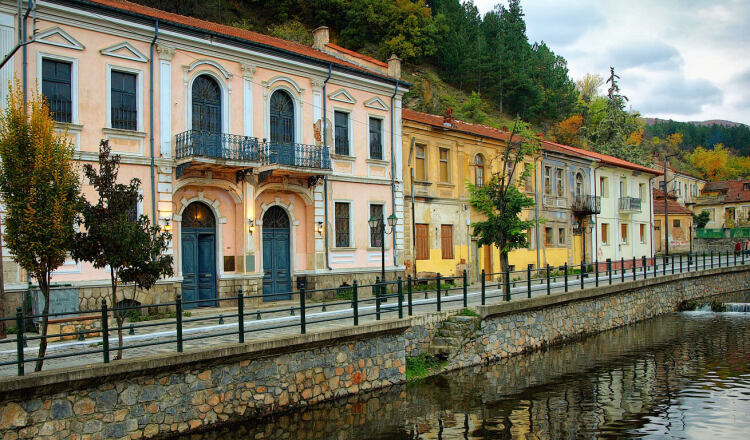
Florina
An outstanding natural landscape dotted with six magnificent lakes (Vegoritida, Petron Lake, Zazari, Ximaritida, Mikri and Megali Prespa), picture-perfect lakeside villages, stone-built villages and a beautiful capital traversed by a river: this was the prominent director’s Theo Angelopoulos favourite filmmaking spot, the place that inspired him deeply to praise beauty and life…
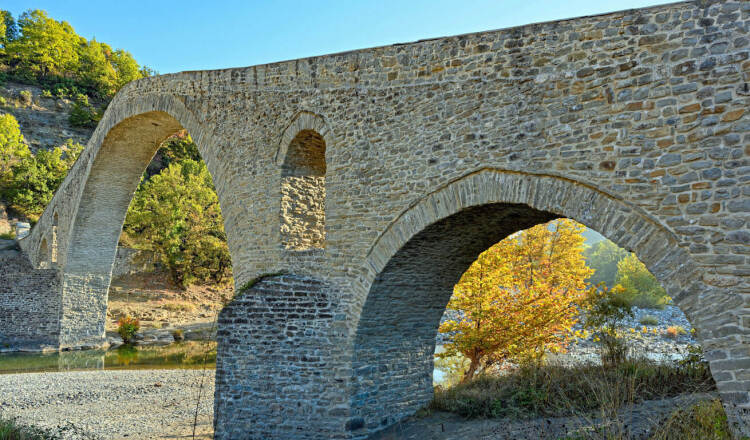
Grevena
An Untouched Paradise for Mountain Lovers
A hidden paradise for travellers who love mountainous landscapes, pristine forests, big rivers and small picturesque villages, the Grevena region casts its spell on visitors from the very first moment.
The high mountains that surround this location and the impressive Aliakmonas River with its numerous tributaries form a unique natural environment. With the Valia Calda forest, which means “warm valley” in the local Vlach dialect, being the undisputed protagonist, Grevena is an ecological paradise for its very few inhabitants, given its size, and for lucky travellers.

Kastoria
The Lakeside Jewel of Northern Greece
This charming town is built on the hillside around a narrow peninsula, nestled between the mountains of Grammos and Vitsi, and washed by the calm waters of Lake Orestiada. The best way to explore the city is to take a tour around the lake starting from the south shore to the north.
Take a stroll on the narrow pathway along the lake’s coast; you will be touched by its beauty and tranquillity. The promenade shaded by beech and plane trees as well as the neighbouring forests create a mystical atmosphere and foster a wide variety of fauna.
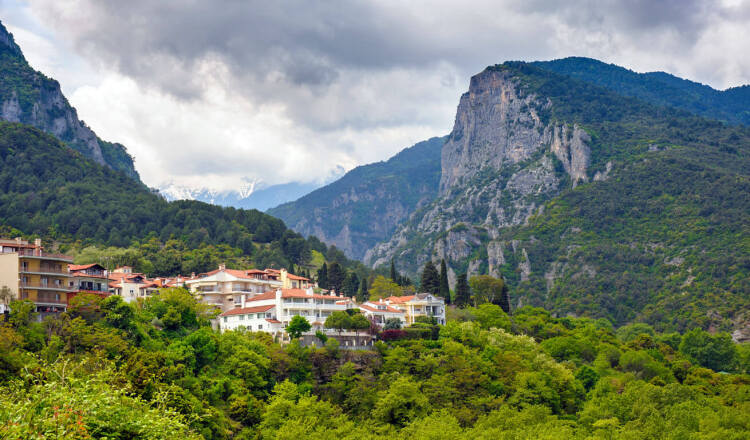
Litochoro
At the Foot of Mount Olympus
It stretches up the mountainside of Olympus’ highest peak (Mytikas, 2,918 m.), yet Litochoro is only a few kilometres away from the sea and that makes it the perfect tourist destination any time of the year! This picturesque town was built following the traditional architecture of Macedonia and the variations of lush vegetation surrounding it enhance the area’s aesthetic harmony. It is a well-structured tourist resort with quality hotel facilities and services and the favourite point of departure for mountaineering trips up the abode of the Olympian gods. The settlement dates back to the 14th century. Following descriptions by foreign and Greek travellers at that time, the majority of residents were mariners and there were also a good many textile workshops in town.
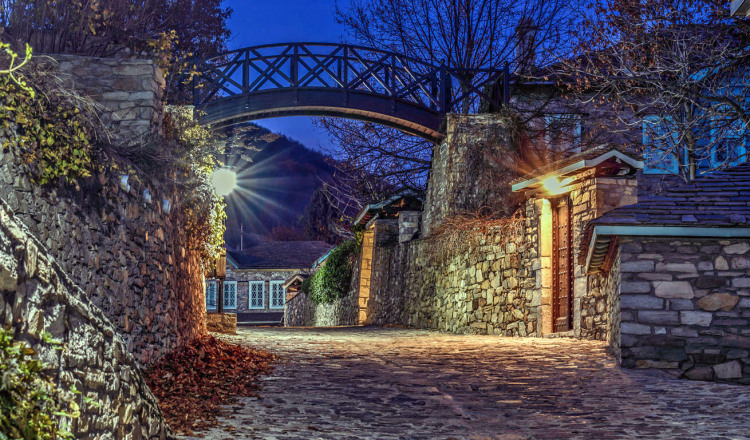
Nymfaio
The land of the Nymphs
Nymfaio is a traditional settlement of Mount Vernon (Vitsi ) at an altitude of 1.350 m. It has been singled out as one of the ten most picturesque villages of Europe, according to UNESCO. This fascinating village with stone built houses and cobblestone paths, surrounded by a breathtaking beech forest, looks like it just came out of a fairytale book. Nymfaio is a year round charming destination as it combines remarkable beauty of nature, a distinctive glorious past, unique traditional guesthouses and numerous cafes and restaurants.

Palaios Agios Athanasios
A Unique Macedonian Settlement
Palaios Agios Athanasios is a top winter destination in Northern Greece, located at the foot of Voras Mountain. At an altitude of 1,200 metres, you’ll come across this captivating traditional settlement formerly known as Tsegani. The Kaimaktsalan ski resort is one of the reasons the village has gained fame and has become a tourist attraction.
During winter holidays the village becomes an attraction to outdoor activity lovers. Embark on your own journey and create memories for a lifetime by skiing, horseback riding, climbing or even (weather permitting) taking a boat ride on lake Vegoritida. Go for a walk on the stone-paved alleys which lead to restored houses bearing local architecture, beautiful hostels, beautiful shops as well as some exhilarating nightlife spots. Also visit the church of Analipseos (17th century) decorated with Byzantine style icons. Finally, pass by the impressive chapel of St. George, where five trees seem to come together forming a human body.

Serres
Serres is a large city in northern Greece with a historical past. It was founded in the 12th century BC and there is a reference of Herodotus to the city called Siris or Peonian.
The city of Serres experienced intellectual and economic growth during the 18th and 19th centuries. It's a beautiful town with loads of nearby destinations that will intrigue you. It is located 587 km NE of Athens and 80 km NE of Thessaloniki.
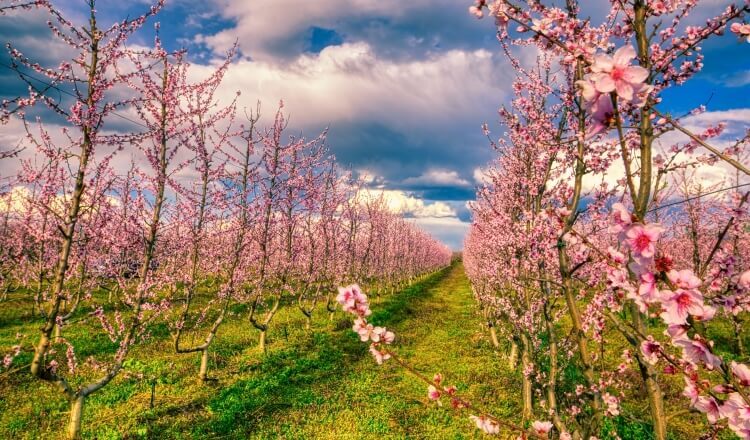
Veria
Veria was the second most significant town, after Aigai, during the blooming ancient Macedonian years. The city is built on the foothills of Mt. Vermion and crossed by the River Tripotamo.
From the 11th to the 14th century it was the third most important city of the Byzantine Empire, after Constantinople (Istanbul) and Thessaloniki. The impressively large number of Byzantine and post-Byzantine churches gave the city the nickname “Little Jerusalem”. Today, 48 Byzantine and post-Byzantine churches are preserved in the city centre.
Follow our footsteps and discover this magnificent historic, yet modern city.

Kozani
The beauty of mountainous Greece
Visitors to the Kozani area are lured by its impressive variety of landscapes, including alpine valleys, steep slopes and ravines, high mountains with dense vegetation, rivers, waterfalls and lakes. Though mostly unknown to travellers, Kozani is an ideal place for road tours leading to beautiful discoveries and aesthetic thrills.
There may be no sea in the area, but this does not mean that more active travellers will be left with little to do. For instance, Kozani has the largest network of marked trails in Greece, extending for 185 kilometres. The trails, varying in degree of difficulty, connect villages and end at mountain peaks or valleys. Moreover, Kozani also offers mushroom picking excursions, wildlife watching at the Deer Park and motocross tracks.
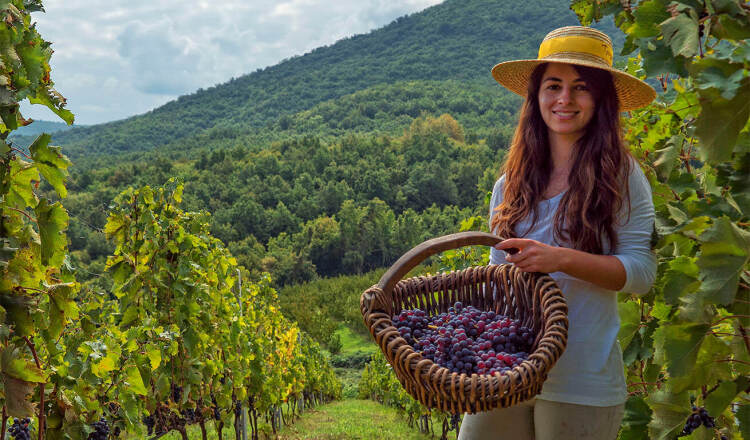
Naoussa
A Year-Round Escape of Wine, Culture, and Mountain Adventures
While many think of Greece as the ultimate summer destination, the charming town of Naoussa, in Macedonia, northern Greece proves that the beauty of this Mediterranean country extends well beyond the hot summer months. Naoussa is a destination for all seasons, but particularly shines in the shoulder months—spring and autumn—when the landscapes are at their most vibrant.
The town of Naoussa and its surroundings offer an alluring mix of natural beauty, historical intrigue, and unique experiences that make it an ideal spot for both winter enthusiasts and those seeking a peaceful retreat amidst rolling vineyards and picturesque mountain ranges.
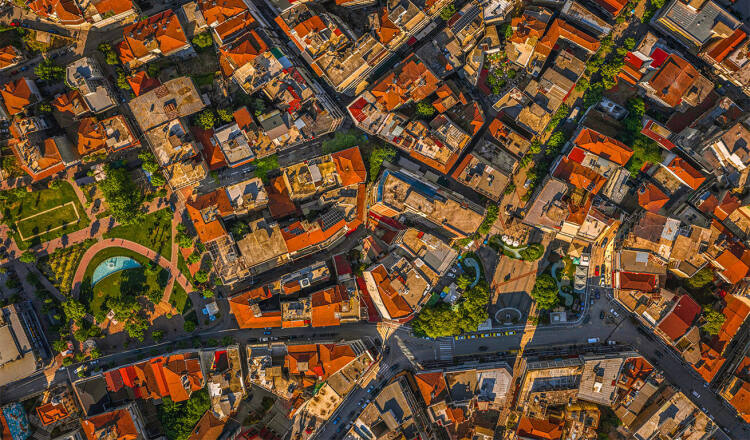
Katerini
A Year-Round Destination
Katerini, Pieria is an inviting destination that has it all: high mountains, green fields and golden beaches. It is a destination to enjoy any time of the year, as it is easy to access, it boasts a delicious cuisine, and a variety of seasonal events to choose from. From the enchanting coastline to the picturesque mountain villages and the legendary Mt. Olympus nearby, Katerini has become ever more popular in recent years, as a place to relax, explore, and enjoy nature.
Macedonian Land
Western Macedonia
It comprises Grevena, Kastoria, Kozani and Florina districts.Must-visit locations:
- The numerous stone-built bridges (particularly the one in Portitsa) in Grevena area.
- Mastorochoria (NW of Grevena town). This is a group of 25 villages that were named after ‘Mastores’ i.e. the stone craftsmen who built the villages from the 18th century until the 1950s.
- Vasilitsa ski centre (45 km W of Grevena) and Vigla Pisoderiou (23 km W of Florina) for snow sports, Valia Kalda (a.k.a. the Pindus National Park) for hiking and off road riding and Deskati for mountaineering (62 km SE of Grevena).
- Ancient Eani (22 km S of Kozani), as it is the most important archaeological site in Western Macedonia, as well as the noteworthy byzantine monuments in the medieval fortified town of Servia (27km SE of Kozani).
- Lake Orestiada (Kastoria) for water sports or for cycling along its perimeter.
- Dispilio (7km SE of Kastoria) to see one of the oldest pile-supported lake settlements in Europe.
- Nestorio where you can join the river party that takes place during the first 10 days of August and practice adventure sports.
- Agios Achillios, the islet in Small Prespa Lake, and Nymfeo, a traditional village 53km SE of Florina.
Central Macedonia
It comprises the following districts: Imathia, Thessaloniki, Kilkis, Pella, Pieria, Halkidiki and the renowned monastic state of Mount Athos.Must-visit locations:
- The great archaeological site of Dion in Pieria, the frankish castle in Platamonas (40km S. of Katerini town) and St. Paul’s Podium in Veria.
- Mt. Olympus for hiking or mountaineering; if you’re interested in snow sports try the ski centres in Seli, Tria-Pente Pigadia and Kaimaktsalan.
- Aiges,the ancient first capital of the kingdom of Macedonia, located in the greater Vergina area. The existing numerous sites of great archaeological and historical importance are the reason why the area has been included in UNESCO’s List of World Heritage Sites in 1996.
- The impressive Edessa waterfalls.
- The Pozar hot springs for relaxing.
- Thessaloniki, a city that is literally an open-air museum. Ancient Greek monuments, roman influences and byzantine grandeur co-exist and create a fascinating mosaic. UNESCO has included 15 early-christian and byzantine monuments in its List of World Heritage Sites, thus recognising the city’s great importance and contribution to the history of mankind.
- the numerous beaches in Halkidiki for swimming and the world renowned Petralona Cave (45km W of Polygyros) where a hominid skull was discovered.
- the numerous vineyards in Goumenissa where some of the best-known Macedonian wines of superior quality are produced.
Eastern Macedonia
It includes Drama, Serres and Kavala districts as well as Thassos Island.Must-visit locations:
- The Amphipolis archaeological site (60km SE of Serres) and the Philippi site (15km NW of Kavala) which has been included in UNESCO’s List of World Heritage Sites in 2016.
- Lake Kerkini for bird watching.
- The impressive Alistrati cave (2km SE of Alistrati town).
- Mt. Pangeo and the Aesthetic Forest in Stena Nestou.
- The ancient monuments on Thassos island and the dreamlike beaches for swimming.

Local Dishes
VIEW ALL

Saragli

Bougatsa (Custard Filled Phyllo Pastry)

Sardine pilaf

Calamari Stuffed with Rice
Tips for your Trips
VIEW ALL
A delicious visit to Thessaloniki's museums
Thessaloniki's Museums with their breathtaking views over the Thermaikos golf or their beautiful green gardens, promise to offer you relaxing spots before or after your culture-oriented visits.

48 hours in Thessaloniki
Thessaloniki is the ideal destination if you’re in the mood for a weekend excursion or a three-day trip. Here are a few tips about how to make the most of your available time even if you can only spend a few hours there.
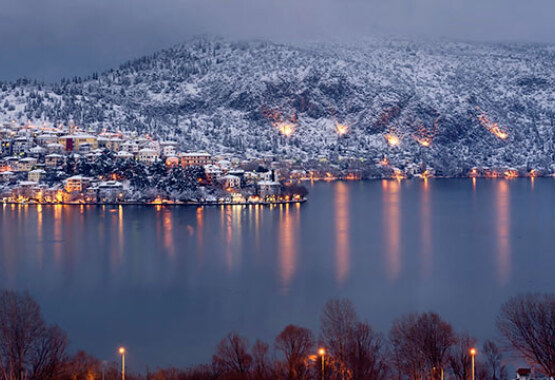
Christmas Destinations in Greece

Villages on Mt Olympus

Thessaloniki of the Arts
Thessaloniki is a multicultural city and an open-air museum; a place with a long history and numerous open air monuments. Walk along the streets and alleys of the city and see the imposing monuments of the Byzantine Period.

